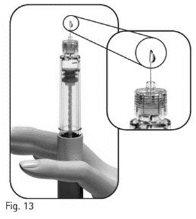
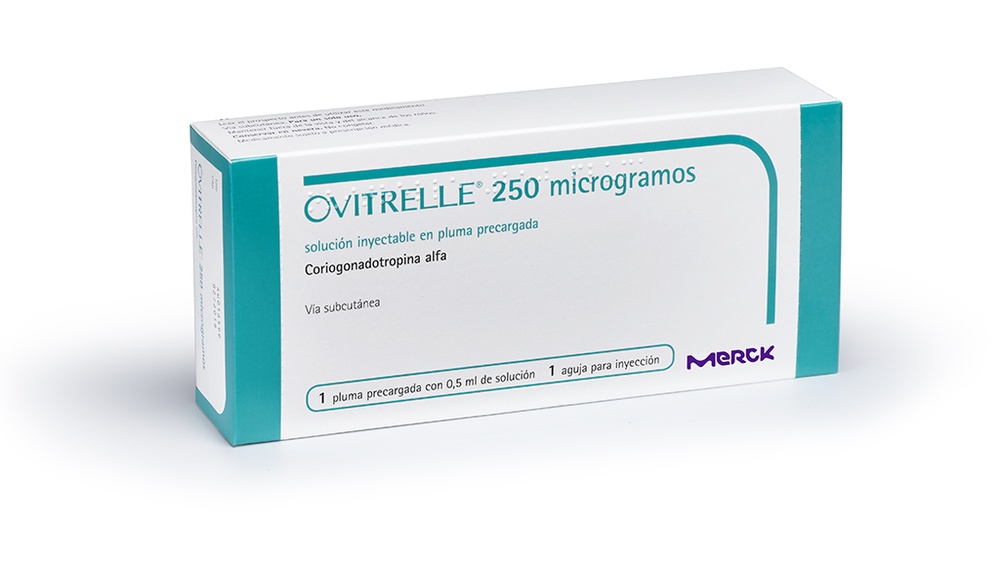
OVITRELLE 250 microgramas Solução Injectável em Caneta Pré-carregada


Como usar OVITRELLE 250 microgramas Solução Injectável em Caneta Pré-carregada
Introdução
Prospecto: informação para o utilizador
Ovitrelle 250microgramas solução injetável em caneta pré-carregada
coriogonadotropina alfa
Leia todo o prospecto atentamente antes de começar a usar este medicamento, porque contém informações importantes para si.
- Conserva este prospecto, porque pode ter que voltar a lê-lo.
- Se tiver alguma dúvida, consulte o seu médico ou farmacêutico.
- Este medicamento foi prescrito apenas para si, e não deve dá-lo a outras pessoas, mesmo que tenham os mesmos sintomas que si, porque pode prejudicá-las.
- Se experimentar efeitos adversos, consulte o seu médico ou farmacêutico, mesmo que se trate de efeitos adversos que não aparecem neste prospecto. Ver secção 4.
Conteúdo do prospecto:
- O que é Ovitrelle e para que é utilizado
- O que precisa saber antes de começar a usar Ovitrelle
- Como usar Ovitrelle
- Possíveis efeitos adversos
- Conservação de Ovitrelle
- Conteúdo do envase e informação adicional
1. O que é Ovitrelle e para que é utilizado
O que é Ovitrelle
Ovitrelle contém um medicamento denominado “coriogonadotropina alfa”, fabricado em laboratório mediante uma técnica especial de ADN recombinante. A coriogonadotropina alfa é semelhante a uma hormona que se encontra no seu organismo de forma natural denominada “gonadotropina coriónica”, que intervém na reprodução e na fertilidade.
Para que é utilizado Ovitrelle
Ovitrelle é utilizado juntamente com outros medicamentos:
- Para ajudar a que se desenvolvam e amadureçam vários folículos (cada um contém um óvulo) em mulheres submetidas a técnicas de reprodução assistida (procedimento que pode ajudá-la a engravidar), tais como a “fertilização in vitro”. Serão administrados primeiro outros medicamentos para desencadear o crescimento de vários folículos.
- Para ajudar a que se libere um óvulo do ovário (indução da ovulação) em mulheres que não podem produzir óvulos (“anovulação”) ou produzem muito poucos (“oligovulação”). Serão administrados primeiro outros medicamentos para desenvolver e amadurecer os folículos.
2. O que precisa saber antes de começar a usar Ovitrelle
Não use Ovitrelle
- se é alérgica à coriogonadotropina alfa, ou a algum dos outros componentes deste medicamento (incluídos na secção 6),
- se tem um tumor no hipotálamo ou na hipófise (ambos são partes do cérebro),
- se tem ovários grandes ou bolsas grandes de líquido dentro dos ovários (quistes ováricos) de origem desconhecida,
- se tem hemorragias vaginais de causa desconhecida,
- se tem um cancro de ovário, útero ou mama,
- se padece de inflamação grave das veias ou coágulos de sangue nas veias (problemas tromboembólicos ativos),
- se apresenta alguma circunstância que por norma impede um gravidez normal, como menopausa ou menopausa precoce (insuficiência ovárica), ou malformações dos órgãos sexuais.
Não use Ovitrelle se se cumprir alguma das anteriores condições. Se não tiver certeza, consulte o seu médico antes de tomar este medicamento.
Advertências e precauções
Antes de iniciar o tratamento, a sua fertilidade e a do seu parceiro devem ser avaliadas por um médico especialista no tratamento de problemas de fertilidade.
Síndrome de hiperestimulação ovárica (SHO)
Este medicamento pode aumentar o risco de que apresente um SHO. Isso ocorre quando os folículos se desenvolvem demasiado e se convertem em grandes quistes.
Se nota dor na parte inferior do abdômen, aumenta de peso rapidamente, tem náuseas ou vomita, ou tem dificuldade para respirar, não se administre a injeção de Ovitrelle e consulte o seu médico imediatamente (ver a secção 4). Se desenvolver um SHO, pode ser indicado que não pratique o sexo ou que utilize um método anticonceptivo de barreira durante pelo menos quatro dias.
O risco de SHO diminui se se utiliza a dose habitual de Ovitrelle e se é controlada cuidadosamente ao longo do ciclo de tratamento (por exemplo, mediante análises de sangue para medir os níveis de estradiol e ecografias).
Gravidez múltipla e/ou anomalias congénitas
Durante o uso de Ovitrelle, tem um maior risco de engravidar de mais de um bebê ao mesmo tempo (“gravidez múltipla”, normalmente de gémeos) do que se conceber de forma natural. A gravidez múltipla pode dar origem a complicações para si e para os seus bebés. Durante o tratamento com técnicas de reprodução assistida, o risco de ter uma gravidez múltipla está relacionado com a sua idade e com a qualidade e o número de óvulos fertilizados ou embriões que se lhe implantam no corpo. As gravidezes múltiplas e certas características específicas dos casais com problemas de fertilidade (p. ex., a idade) podem estar relacionadas também com um aumento das probabilidades de anomalias congénitas.
O risco de gravidezes múltiplas diminui se é controlada cuidadosamente ao longo do ciclo de tratamento (por exemplo, mediante análises de sangue para medir os níveis de estradiol e ecografias).
Gravidez ectópica
Pode produzir-se uma gravidez fora do útero (gravidez ectópica) em mulheres com lesões nas trompas de Falópio (os condutos que transportam o óvulo desde o ovário até o útero). Por isso, o seu médico deve realizar um exame ecográfico precoce para descartar a possibilidade de gravidez fora do útero.
Aborto
Durante o tratamento com técnicas de reprodução assistida ou de estimulação dos ovários para produzir óvulos, tem uma maior probabilidade de ter um aborto do que a média das mulheres.
Problemas de coagulação do sangue (episódios tromboembólicos)
Consulte o seu médico antes de usar Ovitrelle se si ou algum familiar tiveram alguma vez coágulos sanguíneos na perna ou no pulmão, ou um ataque cardíaco ou um acidente vascular cerebral. Pode correr um risco maior de coágulos sanguíneos graves ou de que coágulos existentes se agravem ao receber tratamento com Ovitrelle.
Tumores dos órgãos sexuais
Foram comunicados tumores nos ovários e noutros órgãos sexuais, tanto benignos como malignos, em mulheres que receberam vários tratamentos farmacológicos para a infertilidade.
Testes de gravidez
Se se realizar um teste de gravidez com soro ou urina após usar Ovitrelle, e até dez dias após, pode ocorrer que obtenha um resultado do teste falso positivo. Se não tiver certeza, consulte o seu médico.
Crianças e adolescentes
Ovitrelle não deve ser utilizado em crianças e adolescentes.
Outros medicamentos e Ovitrelle
Informa o seu médico se está a utilizar, utilizou recentemente ou possa ter que utilizar qualquer outro medicamento.
Gravidez e amamentação
Não use Ovitrelle se estiver grávida ou em período de amamentação.
Se estiver grávida ou em período de amamentação, consulte o seu médico antes de utilizar este medicamento.
Condução e uso de máquinas
Não se prevê que Ovitrelle afete a sua capacidade de conduzir ou usar máquinas.
Ovitrelle contém sódio
Este medicamento contém menos de 1 mmol de sódio (23 mg) por dose; isto é, é essencialmente “isento de sódio”.
3. Como usar Ovitrelle
Siga exatamente as instruções de administração deste medicamento indicadas pelo seu médico. Em caso de dúvida, consulte novamente o seu médico ou farmacêutico.
Quantidade a utilizar
- A dose recomendada de Ovitrelle é 1 caneta pré-carregada (250 microgramas/0,5 ml) em uma injeção única.
- O seu médico explicará exatamente quando deve aplicar a injeção.
Uso deste medicamento
- Se se vai a administrar Ovitrelle si mesma, leia atentamente e siga as “Instruções de uso”.
- Ovitrelle é administrado mediante injeção sob a pele (subcutânea).
- Cada caneta pré-carregada é para um único uso.
- O seu médico ou enfermeiro ensinará como usar a caneta pré-carregada de Ovitrelle para injetar o medicamento.
- Administre Ovitrelle do modo que o seu médico ou enfermeiro ensinou.
- Após a injeção, elimine a agulha usada de forma segura e elimine a caneta.
Se usar mais Ovitrelle do que deve
Os efeitos de uma sobredose de Ovitrelle são desconhecidos; no entanto, existe a possibilidade de que se produza um síndrome de hiperestimulação ovárica (SHO), que é descrito mais amplamente na secção 4.
Se esquecer de usar Ovitrelle
Se esquecer de usar Ovitrelle, contacte o seu médico assim que se aperceber.
Se tiver alguma outra dúvida sobre o uso deste medicamento, pergunte ao seu médico ou farmacêutico.
4. Possíveis efeitos adversos
Como todos os medicamentos, este medicamento pode produzir efeitos adversos, embora nem todas as pessoas os sofram.
Se notar algum dos seguintes efeitos adversos graves, interrompa o uso de Ovitrelle e consulte imediatamente um médico, pode que necessite de tratamento médico urgente:
- As reações alérgicas, tais como erupção, pulso acelerado ou irregular, inchaço da língua ou garganta, espirros, sibilâncias ou dificuldade respiratória grave são muito raras (podem afetar até 1 de cada 10.000 pessoas).
- A dor na parte inferior do abdômen, a distensão abdominal ou as molestias abdominais acompanhados de náuseas (ter ganas de vomitar) ou os vómitos podem ser sintomas do síndrome de hiperestimulação ovárica (SHO). Isso pode indicar que os ovários reagiram de forma exagerada ao tratamento e se desenvolveram grandes quistes ováricos (ver também na secção 2 sob “Síndrome de hiperestimulação ovárica”). Estes episódios são frequentes (podem afetar até 1 de cada 10 pessoas).
- O SHO pode chegar a ser grave com ovários claramente aumentados, um decréscimo na produção de urina, aumento de peso, dificuldade respiratória e possível acumulação de líquidos no estômago ou peito. Estes episódios são pouco frequentes (podem afetar até 1 de cada 100 pessoas).
- As complicações graves de coagulação do sangue (episódios tromboembólicos), por vezes independentes do SHO, são observados muito raramente. Estes poderiam provocar dor no peito, falta de alento, acidente vascular cerebral ou ataque cardíaco (ver também na secção 2 sob “Problemas de coagulação do sangue”).
Outros efeitos adversos
Frequentes (podem afetar até 1 de cada 10 pessoas)
- Dor de cabeça.
- Reações locais no local de injeção, tais como dor, vermelhidão ou inchaço.
Pouco frequentes (podem afetar até 1 de cada 100 pessoas)
- Diarreia.
Comunicação de efeitos adversos
Se experimentar qualquer tipo de efeito adverso, consulte o seu médico ou farmacêutico, mesmo que se trate de possíveis efeitos adversos que não aparecem neste prospecto. Também pode comunicá-los directamente através do Sistema Español de Farmacovigilância de Medicamentos de Uso Humano: www.notificaRAM.es. Mediante a comunicação de efeitos adversos, pode contribuir para fornecer mais informações sobre a segurança deste medicamento.
5. Conservação de Ovitrelle
Mantenha este medicamento fora da vista e do alcance das crianças.
Não utilize este medicamento após a data de validade que aparece na etiqueta e no envase após CAD. A data de validade é o último dia do mês que se indica.
Conservar em frigorífico (entre 2 ºC e 8 ºC). Não congelar.
Não utilize Ovitrelle se observar indícios visíveis de deterioração, se o líquido contém partículas ou não é transparente.
Os medicamentos não devem ser jogados nos esgotos nem na lixeira. Pergunte ao seu farmacêutico como se livrar dos envases e dos medicamentos que já não precisa. Desta forma, ajudará a proteger o meio ambiente.
6. Conteúdo do envase e informação adicional
Composição de Ovitrelle
- O princípio ativo é a coriogonadotropina alfa, produzida por tecnologia de ADN recombinante.
- Cada caneta precarregada contém 250 microgramas de coriogonadotropina alfa em 0,5 ml (equivalente a aproximadamente 6.500 Unidades Internacionais, UI).
- Os outros componentes são manitol, metionina, hidrogenofosfato de disódio dihidrato, dihidrogenofosfato de sódio monohidrato, poloxâmero 188, ácido fosfórico (para o ajuste do pH), hidróxido de sódio (para o ajuste do pH) e água para preparações injetáveis.
Aspecto do produto e conteúdo do envase
- Ovitrelle apresenta-se como um líquido transparente, incolor ou ligeiramente amarelado para injeção em uma caneta precarregada.
- Cada caneta contém 0,5 ml de solução.
- É fornecido em embalagens de 1 caneta precarregada e 2 agulhas para injeção (uma de reserva).
Título de autorização de comercialização
Merck Europe B.V., Gustav Mahlerplein 102, 1082 MA Amesterdão, Países Baixos
Responsável pela fabricação
Merck Serono S.p.A., Via delle Magnolie 15, 70026 Modugno (Bari), Itália.
Data da última revisão deste prospecto:05/2025.
A informação detalhada deste medicamento está disponível no site da Agência Europeia de Medicamentos: http://www.ema.europa.eu.
INSTRUÇÕES DE USO
Ovitrelle 250microgramas
Solução injetável em caneta precarregada
Coriogonadotropina alfa
Informação importante sobre a caneta precarregada de Ovitrelle
- Leia as instruções de uso e o prospecto antes de usar a caneta precarregada de Ovitrelle.
- Siga sempre todas as indicações dessas instruções de uso e a formação que lhe foi proporcionada pelo profissional de saúde, pois podem ser distintas das recebidas anteriormente. Esta informação permitirá evitar erros no tratamento ou infecções por picada de agulha ou lesões por quebra do vidro.
- A caneta precarregada de Ovitrelle é apenas para injeção por via subcutânea.
- A caneta precarregada de Ovitrelle é para uso único.
- Cada embalagem de caneta precarregada de Ovitrelle contém uma agulha para a injeção e uma agulha de reserva.
- Use apenas a caneta precarregada de Ovitrelle se o profissional de saúde lhe ensinar como usá-la corretamente.
- Conservar na geladeira.
Nãocongelar.
Nãocompartilhe a caneta nem as agulhas com nenhuma outra pessoa.
Nãouse a caneta precarregada de Ovitrelle se ela caiu, ou se a caneta está rachada ou danificada, pois isso pode causar lesões.
Familiarize-se com a caneta precarregada de Ovitrelle
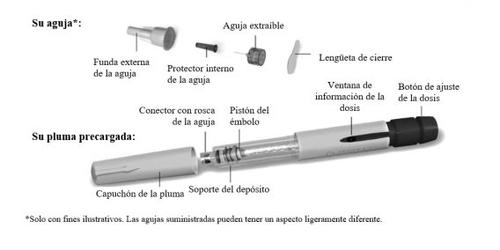
Paso1 Reúna os materiais
1.1Prepare um local limpo e uma superfície plana, como uma mesa ou bancada, em uma zona bem iluminada. |
|
1.2Também necessitará (não incluídos na embalagem):
| |
1.3Lave as mãos com água e sabão e seque-as bem a seguir (Figura 2). | |
1.4Retire com a mão a caneta precarregada de Ovitrelle da embalagem. | |
Nãouse nenhum utensílio, pois seu uso pode danificar a caneta. | |
1.5Verifique que sobre a caneta precarregada está escrito Ovitrelle. 1.6Verifique a data de validade na etiqueta da caneta (Figura 3). | |
Nãouse a caneta precarregada de Ovitrelle se já passou a data de validade ou se na caneta precarregada não está escrito Ovitrelle. |
Paso2 Prepare-se para a injeção
2.1Retire o capuchão da caneta (Figura 4). 2.2Verifique que o medicamento é transparente e entre incolor e amarelado e que não contém partículas. Nãouse a caneta precarregada se o medicamento mudou de cor ou está turvo, pois isso pode causar uma infecção. |
|
Escolha um local de injeção: | |
2.3O profissional de saúde deverá indicar-lhe os locais de injeção que deve utilizar ao redor da zona do estômago (Figura 5). 2.4Limpe a pele do local de injeção com um toalhete umedecido em álcool. Nãotoque nem cubra a pele que acabou de limpar. |
|
Paso3 Acople a agulha
3.1Pegue uma nova agulha. Use apenas as agulhas de uso único fornecidas. 3.2Verifique que a capa externa da agulha não está danificada. 3.3Segure firmemente a capa externa da agulha. |
|
3.4Verifique que a lingueta de fechamento da capa externa da agulha não está danificada ou solta e que não passou a data de validade (Figura 6). |
|
3.5Retire a lingueta de fechamento (Figura 7). |
Nãouse a agulha se está danificada ou vencida ou se a capa externa da agulha ou a lingueta de fechamento está danificada ou solta. Usar agulhas vencidas ou agulhas com linguetas de fechamento ou capas externas da agulha danificadas pode causar uma infecção. Jogue-a em um contenedor para objetos cortantes e perfurantes e use a outra agulha fornecida na embalagem.
Pergunte ao seu profissional de saúde se tiver alguma dúvida.
3.6Enrosque a capa externa da agulha no conector rosqueado da agulha da caneta precarregada de Ovitrelle até que note uma ligeira resistência (Figura 8). Nãoaperte demais a agulha ao acoplá-la, pois poderia ser difícil retirá-la após a injeção. |
|
3.7Retire a capa externa da agulha puxando-a suavemente (Figura 9). 3.8Deixe-a de lado para usar depois (Figura 10). |
|
Nãojogue a capa externa da agulha, pois isso evitará lesões por picada com a agulha e infecções ao separar a agulha da caneta precarregada. 3.9Segure a caneta precarregada de Ovitrelle com a agulha apontando para cima (Figura 11). 3.10Retire cuidadosamente e jogue o protetor interno da agulha (Figura 12). |
|
Nãovolte a tapar a agulha com o protetor interno da agulha, pois isso pode provocar lesões por picada com a agulha e infecções.
3.11Examine minuciosamente a ponta da agulha em busca de uma ou várias gotículas de líquido (Figura 13).
|
|
Se não observa nenhuma gotícula de líquido na ponta ou suas proximidades quando usar uma caneta nova:
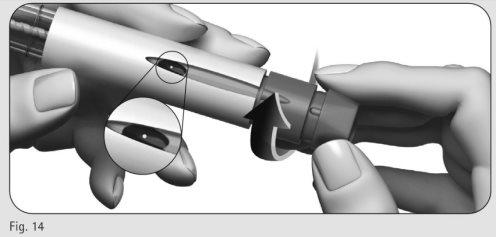
- Gire com cuidado o botão de ajuste da dose para a frente até que veja um ponto (?) na janela de informação da dose (Figura 14).
- Pode girar o botão de ajuste da dose para trás se o moveu além do ponto (?).
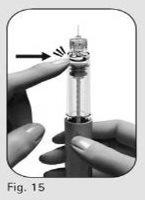
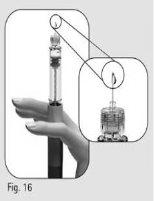
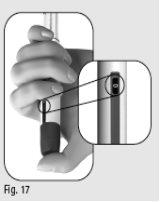
- Segure a caneta com a agulha apontando para cima.
- Bata suavemente no suporte do depósito (Figura 15).
- Pressione o botão de ajuste da dose completamente. Aparecerá uma gotícula de líquido na ponta da agulha (Figura 16)*.
- Verifique que a janela de informação da dose indica “0” (Figura 17).
*Nota: Se não observa nenhum líquido, pode começar de novo no passo 1 (nesta seção) apenas uma vez. Se não aparece uma gotícula de líquido na segunda vez, entre em contato com o profissional de saúde.
Paso4 Selecione a dose de 250
4.1Gire suavemente o botão de ajuste da dose para a frenteaté que apareça “250”na janela de informação da dose. | |
Nãopressione nem puxe o botão de ajuste da dose enquanto o gira. |
|
4.2Verifique que a janela de informação da doseindica “250”(Figura 19) antes de continuar com o passo 5 abaixo. Entre em contato com o profissional de saúde se precisar de ajuda. |
|
Paso5 Injete a dose
Importante:injete a dose como lhe ensinou o profissional de saúde.
5.1Insira lentamente a totalidade da agulha na pele (Figura 20). |
|
5.2Coloque o polegar no centro do botão de ajuste da dose. Pressione o botão de ajuste da dose lentamente e completamentee mantenha-o pressionado para administrar integralmente a injeção (Figura 21). |
|
5.3Mantenha o botão de ajuste da dose pressionado durante um mínimo de 5 segundos antes de retirar a agulha da pele (Figura 22).
|
|
|
Nãosolte o botão de ajuste da dose até ter retirado a agulha da pele.
Paso6 Retire a agulha após a injeção
6.1Coloque a capa externa da agulha sobre uma superfície plana. |
|
6.2Segure firmemente a caneta precarregada de Ovitrelle com uma mão e introduza a agulha na capa externa da agulha (Figura 24). 6.3Continue empurrando a agulha enfundada contra uma superfície firme até que ouça um estalo (“clic”) (Figura 25). 6.4Segure a capa externa da agulha e desenrosque a agulha girando-a na direção oposta (Figura 26). 6.5Jogue a agulha usada de forma segura em um contenedor para objetos cortantes e perfurantes (Figura 27). Maneje a agulha com cuidado para evitar se lesionar com ela. Nãoreutilize nem compartilhe nenhuma agulha usada com nenhuma outra pessoa. |
|
Paso7 Após a injeção
- Verifique se foi administrada uma injeção completa:
|
|
Se a janela de informação da dose mostra “0”, completou a dose.
Se a janela de informação da dose nãomostra “0”, entre em contato com o profissional de saúde.
Nãotente administrar a injeção uma segunda vez.
Paso8 Jogue a caneta precarregada de Ovitrelle
Importante:A caneta precarregada de Ovitrelle e as agulhas fornecidas são para uso único.
|
Entre em contato com o profissional de saúde se tiver alguma pergunta.
Data da última revisão dessas instruções de uso: 05/2025.
- País de registo
- Substância ativa
- Requer receita médicaSim
- Fabricante
- Esta informação é apenas para referência e não constitui aconselhamento médico. Consulte sempre um médico antes de tomar qualquer medicamento. A Oladoctor não se responsabiliza por decisões médicas baseadas neste conteúdo.
- Alternativas a OVITRELLE 250 microgramas Solução Injectável em Caneta Pré-carregadaForma farmacêutica: INJETÁVEL, 150 UI/ 0,25 ml (11 microgramas/ 0,25 ml)Substância ativa: follitropin alfaFabricante: Gedeon Richter Plc.Requer receita médicaForma farmacêutica: INJETÁVEL, 150 UI/ 0,25 ml (11 microgramas/ 0,25 ml)Substância ativa: follitropin alfaFabricante: Gedeon Richter Plc.Requer receita médicaForma farmacêutica: INJETÁVEL, 150 UI/0,25 ml (11 microgramas/0,25 ml)Substância ativa: follitropin alfaFabricante: Gedeon Richter Plc.Requer receita médica
Alternativas a OVITRELLE 250 microgramas Solução Injectável em Caneta Pré-carregada noutros países
As melhores alternativas com o mesmo princípio ativo e efeito terapêutico.
Alternativa a OVITRELLE 250 microgramas Solução Injectável em Caneta Pré-carregada em Ukraine
Médicos online para OVITRELLE 250 microgramas Solução Injectável em Caneta Pré-carregada
Avaliação de posologia, efeitos secundários, interações, contraindicações e renovação da receita de OVITRELLE 250 microgramas Solução Injectável em Caneta Pré-carregada – sujeita a avaliação médica e regras locais.















